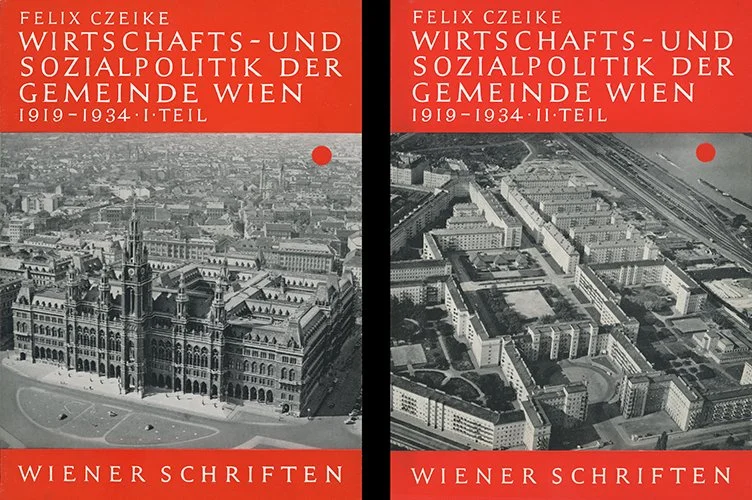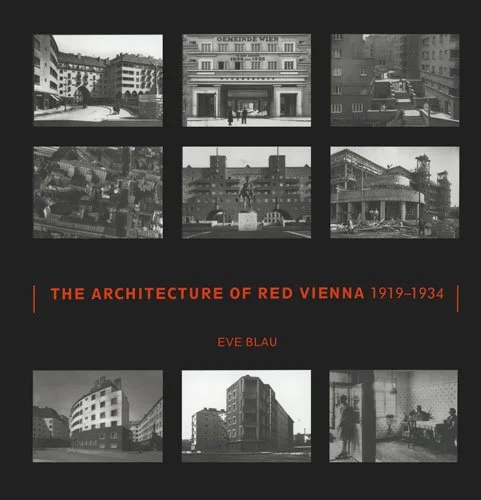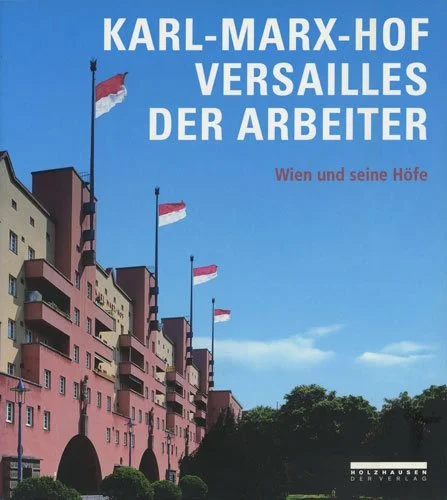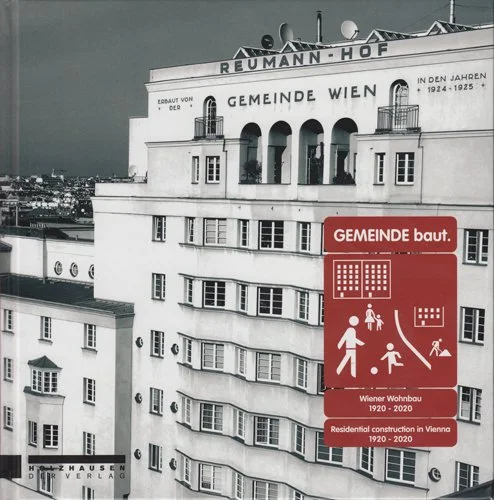Red Vienna – Literature
⭆ Collecting | Books about Red Vienna
Wirtschafts- und Sozialpolitik der Gemeinde Wien 1919-1934. Part I and II. Felix Czeike. Vienna: Jugend & Volk, 1958/59
At the end of the 1950s, the historian Felix Czeike, who would later become the head of the Vienna City and State Archives, published a comprehensive portrayal of the economic and social policies of Red Vienna in two volumes. In the second volume, he also delves into the city's housing policy in detail, providing detailed information on the political prerequisites and financial foundations – however, he does not delve into the architecture of the city's construction projects.
Die Wiener Superblocks. Veröffentlichungen zur Architektur Heft Nr. 23. Joachim Schlandt. Berlin: TU Berlin, 1969
Der Karl Marx-Hof. Prolegomena Nr. 24. Institut für Wohnbau. Vienna: TU Wien, 1978
This slim booklet, published in 1969 by the Technical University of Berlin, is, to my knowledge, one of the earliest publications on the architecture of Red Vienna after the Second World War. It introduces 23 public housing apartment complexes built in Vienna during the 1920s and 1930s by architects Adolf Loos, Hubert Gessner, Karl Ehn and Rudof Perco among others. The introduction by Joachim Schlandt covers various aspects of public housing of the time, e.g. government intervention into the private housing market, selection criteria for occupants, criteria for the location on public housing, maintenance and rent control, and public housing as "gathering points for antisocial elements.”
Kommunaler Wohnbau in Wien. Aufbruch – 1923 - 1934 – Ausstrahlung. Karl Mang. Vienna: Stadt Wien, 1977
Kommunaler Wohnbau in Wien. Aufbruch, Die Leistungen der 2. Republik. Karl Mang. Vienna: Stadt Wien, 1977
Zwischenkriegszeit – Wiener Kommunalpolitik – 1918-1938. Exhibition leaflet. Vienna: Stadt Wien, 1977
Born in Vienna in 1922, Karl Mang studied architecture at the Vienna University of Technology during and after the Second World War. From 1952 he worked as a freelance architect, but was also active as a teacher, writer and institute director. Together with his wife Eva Mang-Frimmel, whom he met at the Technical University, he opened an office in 1954 and created interior designs, large residential complexes and revitalisations. From 1972 to 1983 Mang was president of the Austrian Institute of Design. With the travelling exhibition Kommunaler Wohnbau in Wien 1923-1934 (Municipal Housing in Vienna 1923-1934), which was first shown at the Museum des 20. Jahrhunderts (Museum of the 20th Century) in Vienna in 1977, Karl and Eva Mang were among the first to scientifically reappraise Viennese architecture of the interwar period in Austria. The accompanying exhibition catalogue is today one of the standard works in this field.
Die Gemeindebauten des Roten Wien 1919-1934. Hans Hautmann, Rudolf Hautmann. Vienna: Schönbrunn, 1980
The brothers Hans and Rudolf Peter Hautmann were born in Vienna into a family connected to the labour movement. Hans studied history and German language and literature at the University of Vienna and worked at the Documentation Centre of the Austrian Resistance in Vienna from 1966 to 1968. In 1969 he joined in the Department of Modern History and Contemporary History at the Johannes Kepler University in Linz, where he first became an assistant and from 1981 head of the Department of Austrian History. From 1993 to 2005 Hautmann was President of the Archive and Library Association of the KPÖ, the Communist Party of Austria. His older brother Rudolf Peter was an architect. Together they wrote this early monograph on municipal housing in the city of Vienna in the interwar period – a profunde documentation of the buildings and their architects.
Vienna Rossa. La politica residenziale nella Vienna socialista 1919-1933. Manfredo Tafuri. Milano: Electa, 1980
Manfredo Tafuri (1935-1994) was an Italian Marxist architect, historian, theoretician, critic and academic. In the 1970s, when he was director of the architectural history program at the Istituto Universitario di Architettura di Venezia (IUAV), he travelled to Vienna to investigate the social housing of Red Vienna for the first time from a comprehensive architecture history perspective. The results of this research was bundled in the legendary exhibition Vienna rossa: la politica residential nella Vienna socialista (Red Vienna: housing policy in socialist Vienna), which was shown 1975 in Venice and eventually became the basis of this 1980 publication.
Rotes Wien. Kommunaler Wohnbau in Wien. Helmut Weihsmann. Vienna: Ars Nova Medienverlag, 1981
Rotes Wien. Sozialdemokratische Architektur und Kommunalpolitik 1919-1934. Helmut Weihsmann. Vienna: Promedia, 1985
Das rote Wien. Sozialdemokratische Architektur und Kommunalpolitik 1919-1934. Helmut Weihsmann. Vienna: Promedia, 2002
This ephemeral publication was the accompanying booklet to a series of slides that Helmut Weihsmann compiled on behalf of the Ars Nova publishing house as a teaching aid for schools. It was to be the first of a whole series of essays and books on Red Vienna that the Viennese architectural historian should write in the following years. The most detailed part of the book is devoted to the 23 tours, divided by district. In them, some 500 buildings are described with details of address and year of construction, and presented with photos or maps and often also floor plans. A detailed biography of architects and building artists concludes this lavishly designed volume.
Traum und Wirklichkeit. Wien 1870-1930. Historisches Museum der Stadt Wien. Exhibition catalogue. Vienna: Residenz Verlag, 1984
Exhibition poster by Tino Erben, 1984
The exhibition Traum und Wirklichkeit (Dream and Reality), Vienna 1870-1930 at the Vienna Künstlerhaus marked a turning point in the design of major Austrian historical exhibitions. Staged lavishly by the architect Hans Hollein (1934-2014) and impressively using elements that were completely new at the time, such as replicas, models and ensembles, the exhibition between 28 March and 6 October 1985 was also of central importance for the image and redefinition of Vienna as a European metropolis. With Traum und Wirklichkeit, the diversions profitability of publicly funded events – that publicly funded events were also profitable for the public sector via the "diversions" of private revenues – was addressed for the first time: Large exhibitions subsequently became the focus of cultural policy as an economic factor and stimulus for tourism in Vienna. With 622,000 visitors, the show is still the most visited exhibition of the Wien Museum.
Die Wiener Werkbundsiedlung. Dokumentation einer Erneuerung. Adolf Krischanitz, Otto Kapfinger. Vienna: Compress, 1985
As a building exhibition the Werkbundsiedlung was presented to the public in the summer of 1932. It was designed to show modern house types with sample furnishings as scale models for future housing developments. Originally intended for sale, most of the houses were rented out in the following years and incorporated into the city of Vienna's rental housing stock. In addition to well-known foreign designers such as Gerrit Thomas Rietvelt, Hugo Häring or André Lurcat, the most important Austrian archittects of the interwar period were involved in the construction of the estate: Joseph Frank, Adolf Loos, Joseph Hoffmann, Richard Neutra, Oskar Strnad, Oskar Wlach, Ernst Plischke, Oswald Haerdtl and many others showed their ideas of a humane living culture in the smallest space and with the simplest means. A large part of the houses, as far as they are owned by the municipality of Vienna, were repaired between 1983 and 1985 and restored with careful consideration of formal, technical and functional aspects. This book, published in 1985, documents the revitalisation of the settlement by Austrian architect Adolf Krischanitz and is at the same time the first comprehensive representation of the Werkbundsiedlung in the post-war period.
Die ersten 100 Jahre - Österreichische Sozialdemokratie 1888-1988. Helene Maimann. Vienna: Brandstätter, 1988
Die Arbeiter von Wien – Ein sozialdamokratischer Stadtführer. Kurt Stimmer (Ed). Vienna: Jugend & Volk, 1988
Einfach bauen. Genossenschaftliche Selbsthilfe nach der Jahrhundertwende. Zur Rekonstruktion der Wiener Siedlerbewegung. Klaus Novy, Wolfgang Förster. Vienna: Picus, 1991
Das Rote Wien 1918-1934. Exhibition catalogue. Walter Öhlinger (Ed). Vienna: Museum der Stadt Wien, 1993
Exhibition poster by Tino Erben, 1993
Der Karl-Marx-Hof. Susanne Reppé. Vienna: Picus, 1993
The Architecture of Red Vienna 1919-1934. Eve Blau. Cambridge: MIT Press, 1998
In 1999 architectural history scholar Eve Blau's book has been published as the first comprehensive English-Language analysis of the socialist housing policy implemented in Vienna in the inter-war years. In her 500 page book she looks at how that ideological conflict shaped the buildings of Red Vienna — in terms of their program, spatial conception, language, and use — as well as how political meaning itself is manifested in architecture. She shows how the architecture of Red Vienna constructed meaning in relation to the ideological conflicts that defined Austrian politics in the interwar period. How it was shaped by the conditions of its making, and how it engaged its own codes, practices, and history to stake out a political position in relation to those conditions. Her investigation sheds light both on the complex relationship among political program, architectural practice, and urban history in interwar Vienna, and on the process by which architecture can generate a collective discourse that includes all members of society.
Die Ringstrasse des Proletariats: Hausschmuck der Gemeindebauten 1923-1933. Barbara and Peter Schubert. Vienna: Mayer (2003)
Soziale Bauten, Wien 1920–1938. Markus Kristan. Vienna: Album, 2006
Karl-Marx-Hof – Versailles der Arbeiter. Wien und seine Höfe. Gerald Kriechbaum, Genoveva Kriechbaum (Eds). Vienna: Holzhausen Verlag, 2007
Architektur des Roten Wien. Walter Zednicek. Vienna: Zednicek, 2009
Rotes Wien. Fünf Routen zu gebauten Experimenten, von Karl-Marx-Hof bis Werkbundsiedlung. Inge Podbrecky. Vienna: Falter, 2013
The art historian Inge Podbrecky follows the traces of the residential building activities of Vienna's social democratic city government of the years between 1919 and 1934. Her five city walks lead to the municipal buildings in Margareten and along the Gürtel; to the "classic" Viennese working-class district of Favoriten; to the former "Heimhof" single-kitchen house on the Schmelz; to the most monumental landmark of Red Vienna, the Karl-Marx-Hof, and to the 13th district, to the Werkbundsiedlung, the prime example of architectural modernism in Austria. An updated version of the guide has been published and is still on sale.
Werkbundsiedlung Wien 1932 - Ein Manifest des neuen Wohnens. Wien Museum. Salzburg: Müry Salzmann, 2013
The exhibition, which took place in the Wien Museum in 2013, presented a selected overview of the famous Werkbund building exhibition of 1932. On the one hand, the carefully prepared documentation presented plans, sketches and photos from the time of its creation; on the other hand, this was supplemented by current illustrations and video interviews. As a central element, a model on a scale of 1:100 illustrated the special urban and architectural quality of the settlement. The very detailed and richly illustrated catalogue has been out of print for years.
Das Wunder des Roten Wien. Band I : Zwischen Wirtschaftskrise und Art déco. Harald A. Jahn. Vienna: Phoibos, 2015
Das Wunder des Roten Wien. Band II : Aus den Mitteln der Wohnbausteuer. Harald A. Jahn. Vienna: Phoibos, 2015
Gemeinde baut. Wiener Wohnbau 1920-2020. Stadt Wien (Ed). Vienna: Holzhausen, 2016
The exhibition “Gemeinde baut – Wiener Wohnbau 1920 bis 2020” was held 2016 at the Architekturzentrum Wien (AzW) to commemorate the 90th anniversary of Vienna’s first municipal housing program. The exhibition showcased the evolution of Vienna’s social housing, tracing its development from the 1920s to 2020. It highlighted key milestones, including the ambitious 1923 housing program, which aimed to construct 25,000 apartments in five years. This goal was surpassed, laying the foundation for Vienna’s globally admired approach to affordable, high-quality housing. The exhibition offered a rich historical perspective, emphasizing Vienna’s enduring commitment to social equity and urban development, making it a valuable resource for those interested in urban planning and social architecture.
Das Rote Wien 1919-1934. Ideen – Debatten – Praxis. Wien Museum. Vienna: Birkhäuser, 2019
The first free elections for the Vienna City Council in 1919 gave the Social Democratic Workers' Party an absolute majority. This marked the beginning of an internationally acclaimed reform project aimed at profoundly improving living conditions in the city and significantly democratizing society. The central focus became the housing issue. Funded through "luxury taxes," more than 60,000 apartments, as well as numerous social, recreational, and cultural facilities, were built by 1934. This extensively illustrated publication examines the historical conditions and impacts, international influences and outward appeal, the relationship between ideology and pragmatism, as well as the current potential of this dynamic urban development under the banner of modernity.
Rotes Wien publiziert. Architektur in Medien und Kampagnen. Harald Stühlinger (ed). Vienna: Mandelbaum, 2020
Of the groundbreaking achievements that began in the era of Red Vienna, social housing is probably the best-known product internationally. In addition, however, architecture was also built for education, welfare, leisure facilities, but also for the technical infrastructure of the city. Apart from this large-scale construction offensive for housing and infrastructure buildings, the city government of the time was concerned to achieve an equally powerful internal and external media impact. Parallel to the building activity, a journalistic machinery was set in motion that provided information about the new housing and living in exhibitions, printed books and brochures and produced diverse information and advertising material. Accompanied by this widespread media campaign, some housing estates suddenly became public figures in Red Vienna and stood as famous figureheads for the achievements of the city government both at home and abroad. This anthology presents new findings on the previously unresearched media work of Red Vienna and thus makes an indispensable contribution to understanding this important period of Vienna's urban and architectural history.
Karl-Marx-Hof. Schlüsselbau der Moderne. Cara Tovey, Julian Klinner (eds). Vienna: Mandelbaum, 2024
"When we are no longer here, these stones will speak for us." This prophecy by Vienna's mayor Karl Seitz at the inauguration of the Karl-Marx-Hof on October 13, 1930, has come true. Like no other building, the famous Viennese public housing complex symbolizes the reform project of Red Vienna, aimed at revolutionizing the city. And, unlike most other projects of Vienna’s interwar city administration, the more than one-kilometer-long "giant" in Heiligenstadt became, after World War II, a source of fascination for intellectuals, activists, artists, and journalists.
With the anthology Karl-Marx-Hof. Key Building of Modernity, the international research network BTWH embarks on a historical investigation of the public housing complex. The collection includes contributions on architectural history, political debates, gender, and pop culture by Lilli Bauer, Werner T. Bauer, Eve Blau, Paul Hoehn, Julian Klinner, Rob McFarland, Sara Phenix, Alicia Roy, Mrunmayee Sathye, Joachim Schätz, Georg Spitaler, Cara Tovey, and Marie-Noëlle Yazdanpanah.






















